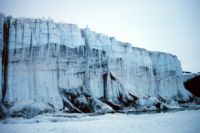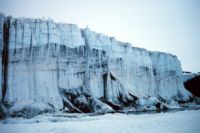Runaway Glacier May Portend Rising Seas

The largest glacier in Greenland doubled its forward progress toward the sea between 1997 and 2003, a new study found. The alarming acceleration coincides with a rapid thinning of the colossal structure, adding water to a rising sea at a faster pace than scientific models have been predicting.
The extra water in the ocean is a drop in the global bucket, but cause for concern nonetheless.
Jakobshavn Isbrae, as it is known, is not the only glacier that's slipping away. Scientists say a warming climate is causing ancient glaciers to retreat suddenly on both the top and the bottom of the world.
Glacial shifts
Glaciers are like giant, slow-moving ice rivers that can be millions of years old. They advance and retreat with climate change.
Glacial shifts usually occur at, well, a glacial pace -- over centuries or millennia. But scientists are now watching that scope of change occur in a matter of years.
The front edge of the Jakobshavn glacier has been retreating, overall, since at least 1850. Starting in late 2000, its inexorable flow toward the sea sped up.
Get the world’s most fascinating discoveries delivered straight to your inbox.
The glacier moved forward at about 3.54 miles (5700 meters) each year between 1992 and 1997. At one point in 2003 its pace was 7.83 miles (12,600 meters) per year.
Suddenly, it nearly doubled the amount of ice it discharges into the sea, researchers say. The glacier has thinned rapidly of late, too, losing roughly 49 feet (15 meters) of its vertical thickness every year since 1997.
All this suggests glaciers are not as stable as once thought. And that, scientists say, could portend more rapid depletion of global ice stores than has been noted so far.
Dramatic change
"In many climate models glaciers are treated as responding slowly to climate change," said Ian Joughin, a glaciologist at the Applied Physics Laboratory at the University of Washington. "In this study we are seeing a doubling of output beyond what most models would predict. The ice sheets can respond rather dramatically and quickly to climate changes."
As more ice moves from glaciers on land into the ocean, it raises sea levels.
And since Jakobshavn Isbrae is a whopper -- it is Greenland's largest outlet glacier, draining 6.5 percent of that continent's ice sheet area -- the changes have increased the rate of sea level rise by about .002 inches (.06 millimeters) per year, or roughly 4 percent of the 20th Century rate of sea level increase, according to the new study.
"This finding suggests the potential for more substantial thinning in other glaciers in Greenland," added Waleed Abdalati, a scientist at NASA's Goddard Space Flight Center who also worked on the investigation. "Other glaciers have thinned by over a meter [3 feet] a year, which we believe is too much to be attributed to melting alone. We think there is a dynamic effect in which the glaciers are accelerating due to warming."
Elsewhere ...
A pair of separate studies, released in September, showed one mechanism by which melting can accelerate rapidly.
The breakup of an Antarctic ice shelf had a snowball effect on the depletion of glaciers it once abutted. In that work, scientists monitored the Larsen B ice shelf, which broke free of the Antarctic Peninsula in 2002.
After the breakup, scientists watched nearby glaciers flow into the sea several times faster than before. They say the ice shelf, now gone, served as a dam, and they attributed the whole situation to a warming climate.
- Windmills to Change Local and Global Climates
- Report: Proof of Global Warming
Glacier Facts
About 10 percent of Earth's land is covered with glaciers.
During the last Ice Age, glaciers covered 32 percent of land.
Glaciers store about 75 percent of the world's fresh water.
Antarctic ice is more than 2.6 miles (4,200 meters) thick in some areas.
If all land ice melted, sea level would rise approximately 230 feet (70 meters) worldwide.
SOURCE: NOAA
Robert is an independent health and science journalist and writer based in Phoenix, Arizona. He is a former editor-in-chief of Live Science with over 20 years of experience as a reporter and editor. He has worked on websites such as Space.com and Tom's Guide, and is a contributor on Medium, covering how we age and how to optimize the mind and body through time. He has a journalism degree from Humboldt State University in California.




